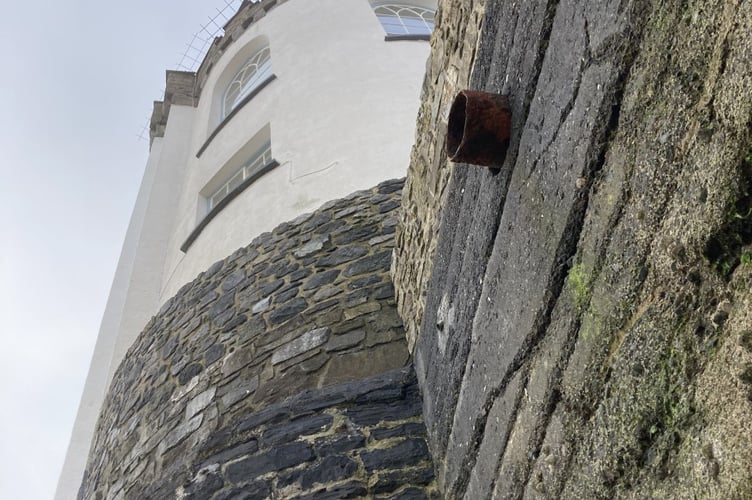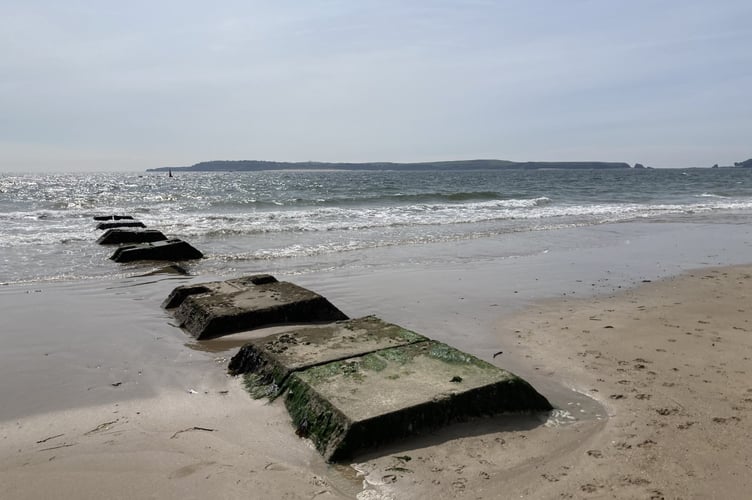A Tenby councillor has challenged Welsh water companies on the frequency of bathing water quality testing in the resort and asked them to identify the cause of the poor seawater quality test results for one of the town’s beaches.
With summer just around the corner, 10 of the County’s beaches, once again get to fly the coveted Blue Flag for 2023 – the most of any county in Wales.
However, even though Tenby’s South and Castle Beaches again picked up the award - which is recognised around the world as a symbol of quality - one popular beach not included on the list again was Tenby’s North Beach, which lost its Blue Flag status last year after the standard of the bathing water dropped down from being rated as ‘Excellent’ to ‘Good’ after an assessment by Natural Resources Wales (NRW) showed that visible pollution was found in the sea from sewage.
A classification of ‘excellent’ water quality is one of the main requirements for applying for a Blue Flag award.
In the following months, Dŵr Cymru announced there would be £15m funding for improving seawater quality, but Tenby was not on the list of areas selected to benefit from this investment, which prompted Councillor Duncan Whitehurst to invite representatives from the water company to an initial meeting with Tenby Town Council to hold them to account for the drop in seawater quality on North Beach.
Recently, representatives from Dŵr Cymru, National Resources Wales and Pembrokeshire County Council agreed to attend the first meeting of the ‘Tenby Clean Seas Working Group’, with the purpose of discussions to look at the performance of the seaside town’s Combined Sewage Overflows (CSOs), better understand the system and determine what investment may be required to improve seawater quality and get the Blue Flag back for North Beach.

The meeting began with Cllr Whitehurst listing 20 occasions when there had been a storm overflow from one of Tenby’s CSOs or when the Surfers Against Sewage app had issued a beach alert. He identified that most storm overflows happened after periods of moderate or heavy rainfall and when the population of Tenby was at its peak during school and summer holidays.
Cllr Whitehurst asked if these storm overflows were the cause of the poor bathing water quality measurements taken by NRW on North Beach and what Dŵr Cymru would do to reduce the frequency of such incidents.
Kelly Jordan of Dŵr Cymru explained the difference between a Storm Overflow, a Beach Alert and a Pollution Incident, with councillors told that a Storm Overspill ‘may or may not contain sewage’ - unlike a Pollution Incident.
The Surfers Against Sewage App releases a Beach Alert when a CSO on that beach issues a storm overflow alert via Dŵr Cymru - but councillors were surprised to hear that when a CSO overspills, the contents of the storm overspill are not tested - so the level of sewage entering the sea is unknown.
Dŵr Cymru stated that Tenby Waste Water Treatment Works could accommodate a theoretical load from a population of 39,000 people, going on to estimate that the winter population of the district served by Tenby WWTW is 9,524, rising to 38,496 in summer.
Councillors were informed that at peak times, the Tenby WWTW never overspills into the long sea outfall, instead, the three pumping stations at Manorbier, Tenby and Saundersfoot would go into overspill to maintain a steady maximum flow through to Tenby WWTW.
Cllr Whitehurst challenged NRW on the frequency of bathing water quality testing and asked them to identify the cause of the poor seawater quality test results on North Beach, with councillors somewhat surprised that neither Dŵr Cymru, NRW, nor Pembrokeshire County Council could determine the cause.
NRW estimated North Beach could regain the Blue Flag status only after at least two years of ‘excellent’ test results.
“It was a constructive and informative meeting with some contentious issues discussed without things becoming heated - however, we have developed a working relationship with Dŵr Cymru and Natural Resources Wales, and hopefully, we might secure some investment to reduce the pollution going into the seas off Tenby,” said Cllr Whitehurst afterwards.
“September 5 is one interesting example of an overspill/beach alert, and it was the one just before the Ironman Wales swim on North Beach which caused some alarm!
“The only way to reduce the sewage content from CSO storm overspills would be to rebuild our sewer system to separate the rainwater from the sewage pipes.

“The Lamack Vale CSO was identified as an asset that could benefit from an upgrade to improve its performance and reduce the number of storm overspills into the River Ritec. Dŵr Cymru promised to look into this.”
Following the meeting, Councillors Whitehurst and Laurence Blackhall decided that more research was needed to determine which CSOs and other assets discharge into the River Ritec, which flows into the sea via the Ritec Culvert on South Beach.
In particular, more information has been requested from Dŵr Cymru regarding St Florence Waste Water Treatment works and the stage 2 treated effluent it discharges into the River Ritec.
“Dŵr Cymru, Natural Resources Wales and Pembrokeshire County Council have agreed to attend a follow-up meeting of the Tenby Clean Seas Working Group in October following the bathing water quality testing results in summer 2023,” continued Cllr Whitehurst.
If any public members would like to join the next TCSWG meeting, please contact Cllr Whitehurst or the Town Clerk.
County councillors from the Local Authority were told this month about Welsh Water investing more than £11m to improve water quality in the River Cleddau, after concerns were raised by Kilgetty and Begelly county Councillor Alistair Cameron over water pollution and quality.
Last month, analysis of sewage dumping statistics released by Welsh Water/Dŵr Cymru painted a grim picture for west Wales, with Ceredigion, Preseli Pembrokeshire, and eastern Carmarthenshire all being in the top 10 constituencies in the UK for sewage dumping.
Figures for West Wales showed Preseli Pembrokeshire being polluted by sewage 5,003 times in 2022, lasting 45,902 hours, while Carmarthen West and South Pembrokeshire was polluted by sewage 3,563 times in 2022 – lasting 26,132 hours.
At the May 11 meeting of PCC’s full council, Cllr Cameron asked a submitted question to members: “Discharge of untreated sewerage is a growing concern around Pembrokeshire’s coast and rivers. Please could the leader or appropriate cabinet member arrange a seminar for all members with Dwr Cymru / Welsh Water so that they can explain what they are doing to reduce the discharge of untreated sewerage?”
Responding, Cabinet Member for Planning and Housing Delivery, Cllr Jon Harvey said he shared the concerns, adding he had contacted both Welsh Water and Natural Resources Wales – as the regulatory body – with a seminar for members expected to take place in early June.
Cllr Harvey also shared a statement from Welsh Water to councillors, which stated: ‘As a company, Welsh Water takes its responsibility to protect the environment seriously and we invest around £1 million a day in improving and maintaining our networks and services.
‘There are many different factors which contribute to river water quality – of which wastewater is one element. We have a strong environmental record and have invested heavily to protect water quality in both our rivers and seas.
‘This has delivered real improvements and helped ensure that Wales has over a third of the UK’s Blue Flag beaches while only having 15 per cent of the coastline and that 40 per cent of our rivers and waterbodies meet good ecological status compared to 16 per cent in England.
‘We recognise however that with environmental legislation tightening and customer expectations changing, more needs to be done.
‘We plan to target our investment to those assets which have the biggest impact on the environment, whether that’s storm overflows operating more than we’d like or too much phosphorus leaving our treatment works. We understand we must improve their performance.’
The statement added: ‘Over the past 18 months, we have updated our Source Apportionment Graphical Information System (SAGIS) water quality models to better understand the impact of our assets on Special Area of Conversation (SAC) rivers in our operating area, that are failing phosphorus targets. The SAC rivers are: Usk, Wye, Teifi, Cleddau and Dee.
‘To help improve the Cleddau, between now and March 2025, we’re investing in four of our sites located along the river. These wastewater treatment works are located at Spittal (£1.5m), Rosemarket (£1m), Letterston (£3.9m) and Wolfscastle (£5m).’
Welsh Water also said it was in touch, and working with, many community groups and organisations in the area.
Manifesto for Rivers in Wales plans to help improve river quality include:
• Investing £1.5 billion in the decade to 2025 on our wastewater system.
• Investing significantly to improve storm overflows with £140m being invested between 2020-2025 with a further £420m planned from 2025 to 2030.
• Investing an additional £60m specifically to reduce phosphorus in the five failing Special Area of Conservation (SAC) rivers in our operating area in our current investment cycle.
• Delivering a comprehensive programme of upgrades and introducing new permits to our treatment works that will reduce our phosphorus contribution by 90 per cent by 2030.
• How our business operating model has allowed us to bring forward over £100m additional investment in our wastewater infrastructure accelerating investment that will have a direct benefit in improving rivers in Wales by 2025.




-11-5-25.jpeg?width=209&height=140&crop=209:145,smart&quality=75)
Comments
This article has no comments yet. Be the first to leave a comment.